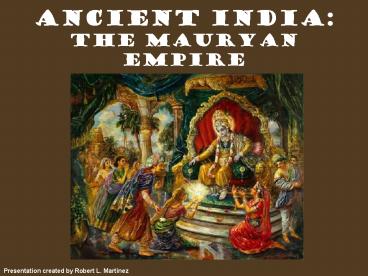Ancient India: The Mauryan Empire - PowerPoint PPT Presentation
1 / 15
Title:
Ancient India: The Mauryan Empire
Description:
Ancient India: The Mauryan Empire Presentation created by Robert L. Martinez Around 330 B.C.E., Alexander the Great conquered the Persian Empire and continued into India. – PowerPoint PPT presentation
Number of Views:431
Avg rating:3.0/5.0
Title: Ancient India: The Mauryan Empire
1
Ancient India The Mauryan Empire
Presentation created by Robert L. Martinez
2
Around 330 B.C.E., Alexander the Great conquered
the Persian Empire and continued into India.
3
During this time, the Aryan culture and belief
systems continued to spread throughout India.
4
Then, around 321 B.C.E., a new empire arose in
India, one that would come to be the largest in
that country to date.
5
Spanning from the Indus River Valley eastward
through the Ganges River Valley and southward
through the Deccan Plateau
6
the Mauryan Empire was founded by Chandragupta
Maurya, who unified the smaller Aryan kingdoms
into a civilization.
7
But it would be his grandson, Ashoka Maurya, who
would take the empire to its greatest heights.
8
A major reason that the Mauryan Empire became so
powerful and wealthy was trade.
9
Indians merchants traded in silk, cotton,
and elephants (among hundreds of other things) to
Mesopotamia and the eastern Roman Empire.
10
Another reason was its powerful military.
Interestingly, it was its military strength that
eventually caused a dramatic change in the
empire.
11
Stricken with disgust by, and filled with
remorse for, a very violent and bloody victory
his forces claimed over the Kalinga in southeast
India, Ashoka converted to Buddhism.
12
For the rest of his reign, Ashoka preached
nonviolence and moderation.
13
Ashoka is also known for his Rock and
Pillar Edicts, which were carved on rocks and
pillars throughout the empire.
14
These edicts reminded Mauryans to live
generous and righteous lives.
15
Following Ashokas conversion and
commitment to Buddhism, the religion spread
beyond India into many parts of Southeast Asia.































